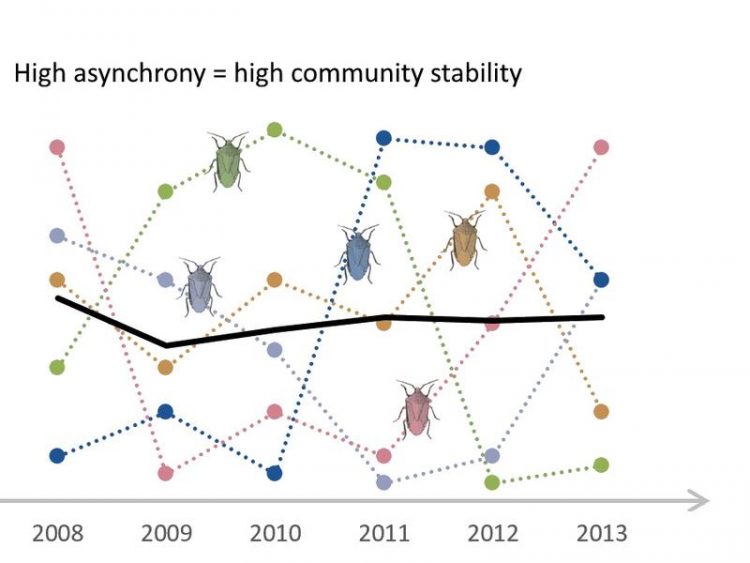Stability in ecosystems: Asynchrony of species is more important than diversity

The abundance of species is subject to natural variations (dotted lines). If the abundance of species varies asynchronously, the abundance of the species community is stable. Dr. M. Gossner/ TUM
The long-term functioning of ecosystems depends on the stability of their species communities, as these ensure the functioning of the entire system. However, land use causes a reduction of the number of species in many ecosystems.
Accordingly, when it comes to conserving species diversity and providing sustainable protection for natural resources, the stability of such animal and plant communities is the main goal of nature conservation and ecosystem management. In principle, higher species diversity and greater asynchrony can increase the stability of the species community. But if land use is intensified or changed, which of these factors – species diversity or asynchrony – is more important?
Six-year-plus study on over 2,600 species
For their study, the researchers evaluated over 2,600 species ranging from insects and spiders, to birds and bats and through to herbaceous plants over a period of six years. Data from 150 forests and 150 pastures and meadows located in three regions in Germany were collated. “The results show that a change in the use of a landscape, for example when a managed forest is converted into grassland, destabilizes the animal and plant community,” explains Dr. Martin Goßner from the Terrestrial Ecology Research Group at the TU Munich.
“Similarly, the intensification of land use results in the destabilization of the animal and plant community and this, in turn, impairs the entire ecosystem,” adds Dr. Nadja Simons (also from the TU Munich). Animal communities presented a stronger reaction here than their plant counterparts. The most severe reaction by far was observed among birds and bats, which can therefore be seen as indicators of land-use intensity.
The more asynchronous the species, the more stable the ecosystem
What is new about the insights gained in this study is the extent to which the asynchrony of the species can increase the stable interplay of animals and plants in an ecosystem: “The more asynchronously the species develop and act, the more stable the system,” says Prof. Nico Blüthgen from the Department of Biology at TU Darmstadt. “We can compare it to the stock exchange, where risk-averse investors are encouraged not to put all their eggs in one basket and to create a portfolio of different securities instead.
This is referred to as the portfolio effect. And, just as in nature, in order to cushion the impact of fluctuations in the investments over time, it is important that the portfolio not only contains a lot of investments but also different types of investments.” Asynchrony thus assumes a key role in the interaction between diversity and stability. The scientists plan to investigate the factors that lead to greater asynchrony in further studies.
This joint project by several research groups was the most comprehensive study on the topic of stability to date and was carried out in the context of the “Biodiversity Exploratories” research alliance. This alliance is funded by the Deutsche Forschungsgemeinschaft (DFG, German Research Foundation). One of its express aims is to facilitate long-term studies of this kind, as impacts on the stability of ecosystems can only be studied effectively from a long-term perspective.
The following universities participated in the research:
• TU Munich
• TU Darmstadt
• Ulm University
• University of Bern
• University of Vienna
• WWU Münster
Publication:
Nico Bluethgen, Nadja K. Simons, Kirsten Jung, Daniel Prati, Swen C. Renner, Steffen Boch, Markus Fischer, Norbert Hoelzel, Valentin H. Klaus, Till Kleinebecker, Marco Tschapka, Wolfgang W. Weisser & Martin M. Gossner: Land use imperils plant and animal community stability through changes in asynchrony rather than diversity, 12.2.16.
DOI: 10.1038/ncomms10697
Download High-Res. Pictures: https://mediatum.ub.tum.de/?id=1293350#1293350
Contact:
Dr. Martin Goßner, Dr. Nadja Simons
Technical University of Munich
Department for Ecology and Ecosystem Management
Terrestrial Ecology Research Group
Hans-Carl-von-Carlowitz-Platz 2
85354 Freising
Tel.: +49(0)8161-71-3713
E-Mail: martin.gossner@tum.de
nadja.simons@tum.de
Prof. Dr. Nico Blüthgen
Department of Biology
Technical University of Darmstadt
Schnittspahnstr. 3
64287 Darmstadt
E-Mail: bluethgen@bio.tu-darmstadt.de
Prof. Dr. Wolfgang W. Weisser
Technical University of Munich
Department for Ecology and Ecosystem ManagementTerrestrial Ecology Research Group
Hans-Carl-von-Carlowitz-Platz 2
D-85354 Freising
Tel: 08161-71-3496/ -3495
E-Mail: wolfgang.weisser@tum.de
https://www.tum.de/en/about-tum/news/press-releases/short/article/32938/
Media Contact
All latest news from the category: Ecology, The Environment and Conservation
This complex theme deals primarily with interactions between organisms and the environmental factors that impact them, but to a greater extent between individual inanimate environmental factors.
innovations-report offers informative reports and articles on topics such as climate protection, landscape conservation, ecological systems, wildlife and nature parks and ecosystem efficiency and balance.
Newest articles

NASA: Mystery of life’s handedness deepens
The mystery of why life uses molecules with specific orientations has deepened with a NASA-funded discovery that RNA — a key molecule thought to have potentially held the instructions for…

What are the effects of historic lithium mining on water quality?
Study reveals low levels of common contaminants but high levels of other elements in waters associated with an abandoned lithium mine. Lithium ore and mining waste from a historic lithium…

Quantum-inspired design boosts efficiency of heat-to-electricity conversion
Rice engineers take unconventional route to improving thermophotovoltaic systems. Researchers at Rice University have found a new way to improve a key element of thermophotovoltaic (TPV) systems, which convert heat…



